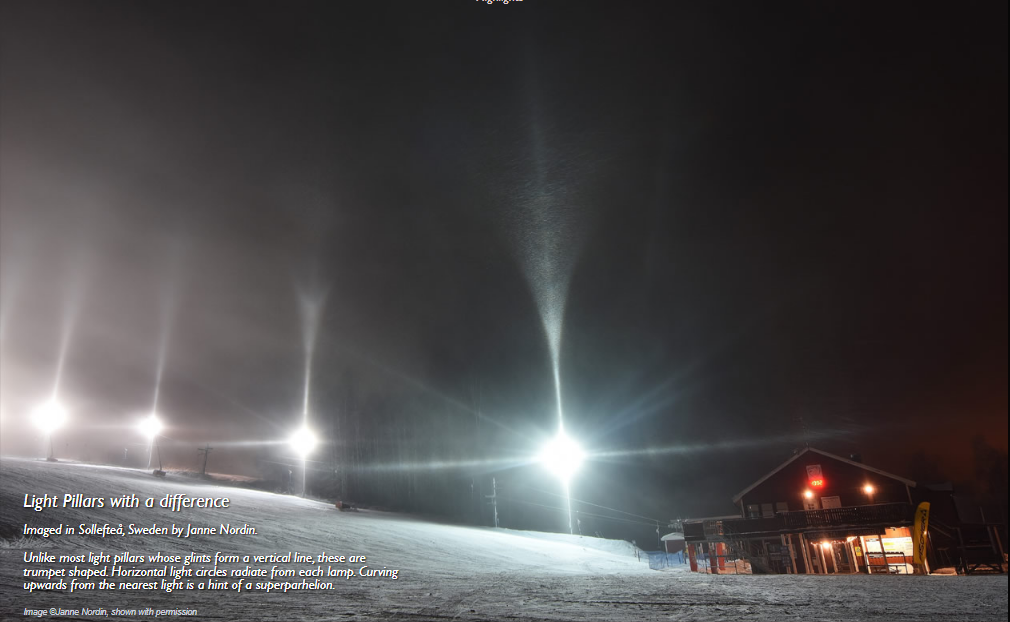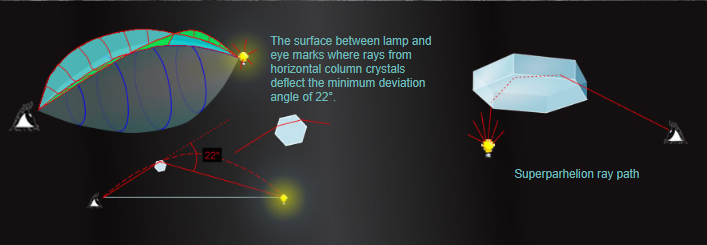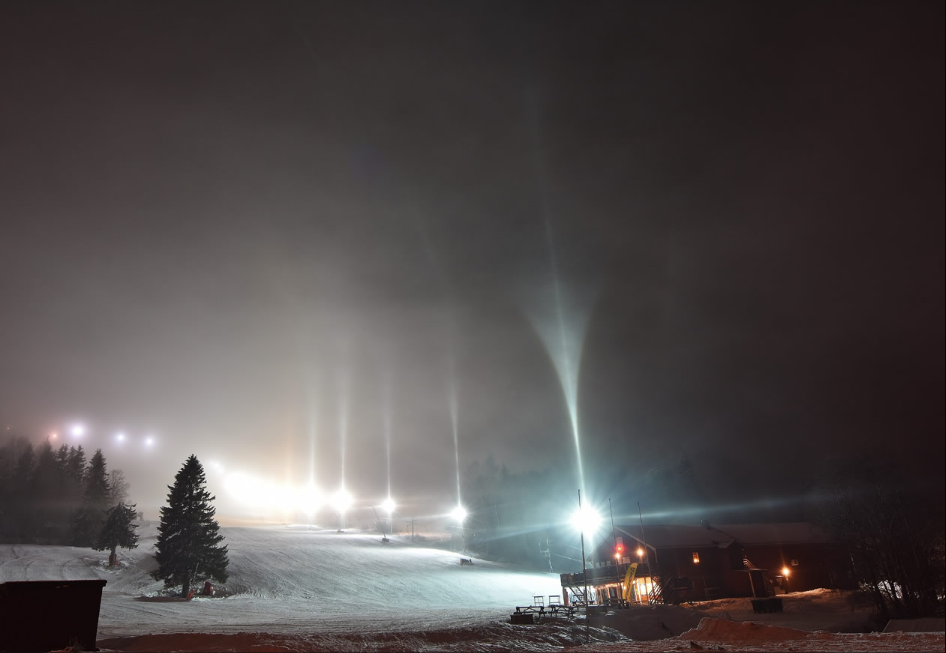Divergent Light Pillars and Halos, Sweden
Divergent Light Pillars and Halos: A Captivating Atmospheric Phenomenon in Sweden
The enchanting phenomenon of light pillars and halos in the skies above Sollefteå, Sweden, never ceases to amaze. While most light pillars form a vertical line, these unique pillars take on a trumpet shape, creating a mesmerizing spectacle for observers. Photographer Janne Nordin captured this captivating display, where horizontal light circles radiate from each lamp, accompanied by a faint hint of a superparhelion curving upwards from the nearest light.
These trumpet-shaped light pillars are a divergent light form of the well-known upper tangent arc that crowns a 22° halo. The glints of light are created by horizontal column diamond dust crystals present in the nearby air. However, only those crystals positioned near the complex green and blue caustic surface are capable of reflecting lamplight towards the observer's eye. This selective reflection contributes to the formation of the distinct trumpet shape.
In addition to the trumpet-shaped pillars, there are also horizontal streaks visible in the sky, known as the divergent light form of the parhelic circle. These streaks are formed by the reflection of light from the near-vertical end faces of column crystals, with plate crystals potentially playing a role as well.
Amongst this ethereal display, one can also observe a faint parabolic superparhelion. This particular divergent light halo is created by plate crystals. The superparhelion adds another layer of intrigue to the overall atmospheric optics phenomenon taking place in Sollefteå.
It is important to note that this article has been automatically converted from its original format and may not appear as intended. For the original article, please refer to the provided link.
The Fascinating Science Behind Divergent Light Pillars and Halos
To fully appreciate the captivating beauty of these divergent light pillars and halos, it is essential to understand the scientific processes at play. Here's a closer look at the key factors contributing to this extraordinary atmospheric optics phenomenon:
-
Diamond Dust Crystals: The presence of horizontal column diamond dust crystals in the air near the light source is crucial for the formation of the trumpet-shaped light pillars. These tiny ice crystals act as prisms, refracting and reflecting light in specific directions.
-
Selective Reflection: The selective reflection of lamplight by diamond dust crystals positioned near the green and blue caustic surface creates the distinct trumpet shape. This phenomenon occurs due to the intricate interplay between the crystal orientation and the incident light.
-
Parhelic Circle: The horizontal streaks observed alongside the trumpet-shaped pillars are the divergent light form of the parhelic circle. This optical phenomenon arises from the reflection of light by the near-vertical end faces of column crystals. Plate crystals may also contribute to this effect.
-
Superparhelion: The presence of plate crystals in the atmosphere gives rise to the faint parabolic superparhelion. These crystals refract and reflect light in such a way that an additional halo appears, further enhancing the overall spectacle.
The Magic of Light Pillars and Halos
Witnessing these divergent light pillars and halos in person is a truly magical experience. The combination of atmospheric conditions, crystal formations, and precise angles results in a breathtaking display of light and color. Here are some key elements that contribute to the enchantment:
-
Unique Atmospheric Conditions: Specific weather conditions, such as extremely cold temperatures, are necessary for the formation of diamond dust crystals and plate crystals, which are vital components in creating these optical phenomena.
-
Crystal Formation: The intricate structure and orientation of diamond dust crystals and plate crystals play a crucial role in determining how light is refracted and reflected, ultimately shaping the appearance of the light pillars and halos.
-
Angles and Perspectives: The observer's position in relation to the light source and crystal formations greatly influences the appearance of the phenomena. Each observer may perceive the display slightly differently, adding to the individuality of the experience.
-
Natural Beauty: The awe-inspiring beauty of these atmospheric optics phenomena serves as a reminder of the wonders that exist in the natural world. The delicate interplay of light, ice crystals, and atmospheric conditions creates a captivating scene that leaves observers in awe of nature's artistry.
In conclusion, the divergent light pillars and halos observed in Sollefteå, Sweden, offer a remarkable glimpse into the world of atmospheric optics. The trumpet-shaped pillars, accompanied by streaks and superparhelion, showcase the intricate interplay between light and ice crystals in the atmosphere. As we marvel at these enchanting displays, we are reminded of the boundless beauty and complexity of our natural surroundings. So, keep your eyes to the sky and embrace the wonder of atmospheric optics.

Light Pillars with a difference
Imaged in Sollefteå, Sweden by Janne Nordin.
Unlike most light pillars whose glints form a vertical line, these are trumpet shaped. Horizontal light circles radiate from each lamp. Curving upwards from the nearest light is a hint of a superparhelion.
Image ©Janne Nordin, shown with permission

The trumpets are a divergent light form of the familiar upper tangent arc atop a 22° halo. Glints from horizontal column diamond dust crystals in the nearby air form them. Only those near the complex green and blue caustic surface glint lamplight towards the eye. More about them here..
The horizontal streaks are the divergent light form of the parhelic circle. Light reflected from the near vertical end faces of column crystals form them. Plate crystals might also weight in.
The faint parabolic superparhelion is another divergent light halo, this time from plate crystals. More here....

Note: this article has been automatically converted from the old site and may not appear as intended. You can find the original article here.
Reference Atmospheric Optics
If you use any of the definitions, information, or data presented on Atmospheric Optics, please copy the link or reference below to properly credit us as the reference source. Thank you!
-
<a href="https://atoptics.co.uk/blog/divergent-light-pillars-and-halos-sweden/">Divergent Light Pillars and Halos, Sweden </a>
-
"Divergent Light Pillars and Halos, Sweden ". Atmospheric Optics. Accessed on November 22, 2024. https://atoptics.co.uk/blog/divergent-light-pillars-and-halos-sweden/.
-
"Divergent Light Pillars and Halos, Sweden ". Atmospheric Optics, https://atoptics.co.uk/blog/divergent-light-pillars-and-halos-sweden/. Accessed 22 November, 2024
-
Divergent Light Pillars and Halos, Sweden . Atmospheric Optics. Retrieved from https://atoptics.co.uk/blog/divergent-light-pillars-and-halos-sweden/.